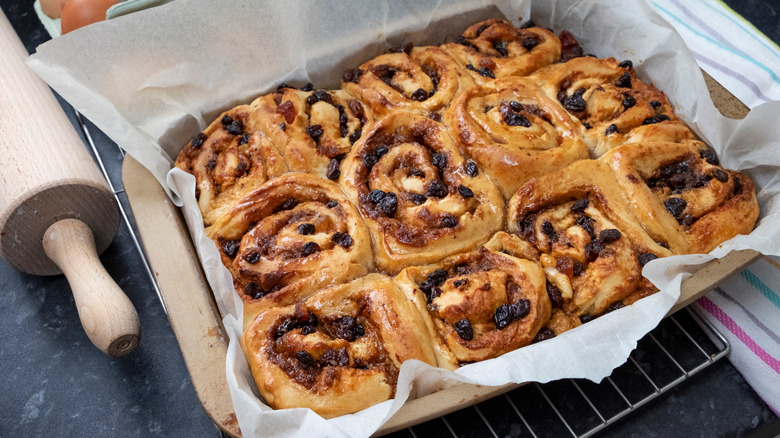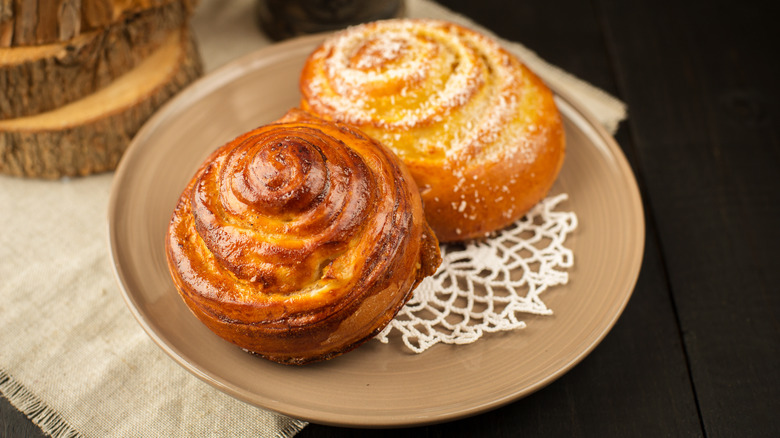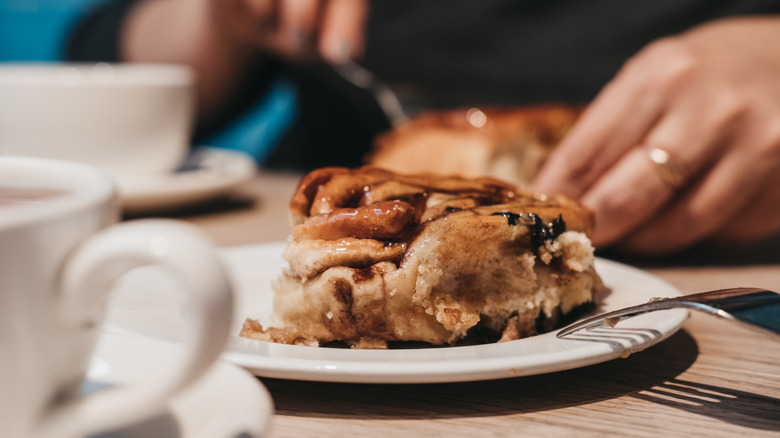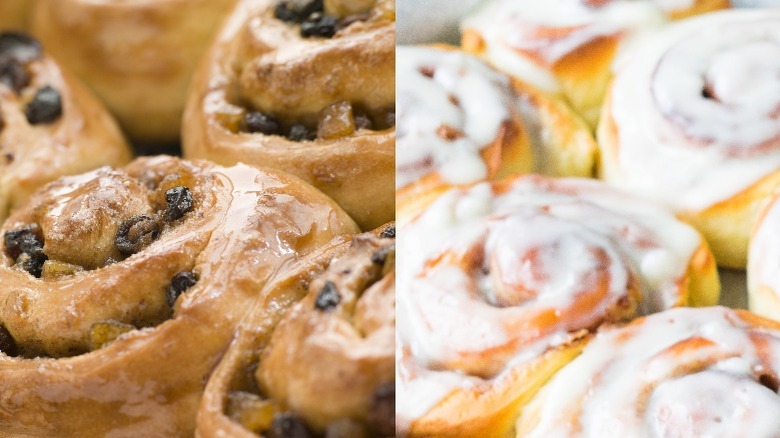Chelsea Buns Are Unfrosted British Cinnamon Rolls That Belong On Your Breakfast Menu
While the world seems to be shrinking all the time, one of the ways in which each country preserves just a bit of its own je ne sais quoi is through its foodways, and the U.K., while quite similar to the U.S. in many aspects, does have delightfully different cuisine. When it comes to baked goods alone, the British Isles have a number of treats that aren't too well-known in the U.S. outside of specialty import stores. Through watching "The Great British Baking Show," though, we've learned of (and envied) such delights as Bakewell tarts, Battenberg cake, and a sweet coiled treat, Chelsea buns.
Chelsea buns, which featured prominently in GBBO's Season 11 finale, are made from yeast dough and are put together by coiling dough into circular, oval, or occasionally even squarish shapes. If all that sounds familiar, American cinnamon rolls are often made the same way. Chelsea buns, however, do not always contain cinnamon, and in fact, it is possible that this ingredient may have been added to make them more closely resemble their American counterparts.
Chelsea buns have been around for at least three centuries
Chelsea buns were known as far back as the 18th century, although we do not have the exact date that they came into being. We do, however, have a place, that being London's Chelsea neighborhood. Over the years, the bun's eponym has been home to such celebs as Mick Jagger, Elton John, and Oscar Wilde. Back in 1711, it was also visited by Jonathan Swift, the author of "Gulliver's Travels." As Swift wrote in a letter to his friend Esther Johnson that was later reprinted in a collection called "The Journal to Stella" (his nickname for her), "Pray, are not the fine buns sold here in our town; was it not Rare Chelsea buns? I bought one today in my walk; it cost me a penny; it was stale, and I did not like it."
While we don't know which bun bakery Swift patronized, we do know that there were several in operation in the early 1700s. One of these, the Chelsea Bun House, must have baked better buns than the one Swift ate, as it enjoyed the patronage of royals including Kings George II and III and their respective queens Caroline and Charlotte. This establishment went out of business in 1839, but not before one last burst of booming bun business. On Good Friday that year, nearly a quarter of a million Chelsea buns changed hands.
What goes into a Chelsea bun?
Chelsea buns are made with yeasted dough that contains bread flour (called strong flour, in the U.K.) and usually milk and eggs. The dough often contains sugar, but not too much, so it's only slightly sweet.
The real flavor in a Chelsea bun comes from the filling, which is made from a base of butter and sugar (either brown or white). The filling typically contains dried fruit of some sort, as well, such as currants or sultanas, the latter being another name for golden raisins. Paul Hollywood of GBBO fame also adds dried cranberries and apricots to his version. While his Chelsea buns are flavored with cinnamon, mixed spice — which is a pumpkin pie spice-like combination of allspice, cinnamon, cloves, coriander, ginger, mace, and nutmeg — is also an option. And originally the buns might not have been filled with any spice at all. Sometimes citrus zest is added to the filling as well.
As a final touch, Chelsea buns are typically finished off with a sugar glaze of some sort. This can be as simple as caster (or very fine granulated) sugar mixed with water, though Paul Hollywood likes to use melted apricot jam instead and follow up with a drizzle of orange-flavored powdered sugar icing.
How they stack up to American cinnamon rolls
Cinnamon rolls differ from recipe to recipe, with creative cooks even coming up with variants including s'mores and carrot cake flavors. Still, if there is an archetypal American cinnamon roll, it would have to be the one sold by Cinnabon (or recreated at home with copycat recipes). Like Chelsea buns, the Cinnabon-style cinnamon roll is made from yeasted dough. This dough, though, may be somewhat sweeter than that used for a Chelsea bun.
The cinnamon roll filling is different in that the butter and sugar mixture is always, always dominated by cinnamon — otherwise, you wouldn't have a cinnamon roll at all. While Cinnabon does not put fruit of any kind in its rolls, some cinnamon rolls do contain raisins and less-standard variants may include all manner of add-ins including nuts, bacon, and Nutella. The typical cinnamon bun topping, too, is quite different from that used for Chelsea buns. While Chelsea buns (Paul Hollywood's aside) are generally brushed with a light, clear, crunchy sugar coating, cinnamon rolls may have a softer, thicker frosting made from powdered sugar. In the case of Cinnabon, the chain even goes all-out with a gooey cream cheese frosting that adds a certain tang that Chelsea rolls tend not to have.



